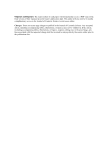327 Topical Apple Derivatives
procyanidin B-2. For 4 months, 1.8 mL of the test agent was applied to the subjects’ affected
area of the head twice a day. No use of other hair care products except shampoos and rinses
was permitted during the clinical trial. Results showed that the increased ratio of hairs
measuring more than 40µm in diameter after 4 months of procyanidin B-2 treatment
was significantly higher than that of the placebo controls (p 0.05). Nearly 80% of the
subjects in the procyanidin B-2 group observed an increased mean value of hair diameter, in
comparison to the 30% in the placebo group (p 0.02). The increase in the number of total
hairs in the designated scalp area (0.25 cm2) of procyanidin B-2 subjects after a 4-month
trial was significantly greater than that of the placebo controls (p 0.001). 84.2% of the
subjects in the procyanidin B-2 group showed an increased hair density, in comparison to
20.0% in the placebo group (p 0.002). The number of total hairs in the designated area
(0.5 cm squared =0.252 cm area) after 4 months of procyanidin B-2 treatment significantly
increased over the baseline figure for each subject (p 0.002). Comparatively, no significant
difference was observed in the placebo controls. Overall, 63.2% of subjects in the procyanidin
B-2 group demonstrated hair-growing effects after the 4-month trial, while only 20% of the
placebo group demonstrated hair-growing effects (p 0.05).
Another double-blind, randomized clinical study consisted of 29 male subjects experiencing
male pattern baldness, and observed the effects of 1% procyanidin B-2 agent, a Malus
pumila derivative, over 180 days (Table II).5 The treatment group of 19 men was treated
with 2 mL of 1% procyanidin B-2 agent twice a day, while the control group of 10 men
was given the vehicle for the 1% procyanidin B-2 only as a placebo. However, this study
observed the effects on hair growth for 6 months rather than 4 months. Results showed
that the treatment group had a significantly greater increase in the number of total hairs in
the designated scalp area in comparison to the control group (p 0.005).5 The treatment
group also had a significantly greater increase in the number of terminal hairs than the
control group (p 0.02).5
The third study was also a double-blind, randomized clinical trial that tested the effects of
procyanidin extracted from Malus pumila on 43 men over 12 months (Table II).16 The study
consisted of one treatment group of 22 men who were treated with 0.7% apple procyanidin
oligomers twice daily and one control group of 22 men who were given the vehicle used for
the procyanidin only as a placebo. The effects of the treatments were assessed at 6 and 12
months. The apple procyanidin oligomers used on the treatment group consisted of 7.3%
(w/w) procyanidin B-1, 26.2% (w/w) procyanidin B-2, and 7.7% (w/w) procyanidin C-1. At
6 months, the treatment group showed a significantly greater increase in the total number
of hairs in the designated scalp area in comparison to the control group (p 0.001).16 At
12 months, the total number of hairs in the designated area of the treatment group was
significantly increased in comparison to that of the treatment group at the start of the trial
(p 0.005).16
A fourth study tested the effectiveness of Annurca polyphenolic extract in counteracting
patterned hair loss in mice (Table II). The study tested mice with a special foam with
AnnurtriComplex® (Mb Med., Turin, Italy), a special procyanidinic extract of Annurca
apple.4 The effects of the foam were analyzed by immunofluoroscopy, scanning electron
microscopy, and energy dispersive X-ray. The hair follicles of mice treated with the foam
appeared to be increased in length compared to those treated with the placebo. Upon
analysis, they showed increased mitochondrial β-oxidation (p 0.05) and increased
mitochondrial activity (p 0.001).
procyanidin B-2. For 4 months, 1.8 mL of the test agent was applied to the subjects’ affected
area of the head twice a day. No use of other hair care products except shampoos and rinses
was permitted during the clinical trial. Results showed that the increased ratio of hairs
measuring more than 40µm in diameter after 4 months of procyanidin B-2 treatment
was significantly higher than that of the placebo controls (p 0.05). Nearly 80% of the
subjects in the procyanidin B-2 group observed an increased mean value of hair diameter, in
comparison to the 30% in the placebo group (p 0.02). The increase in the number of total
hairs in the designated scalp area (0.25 cm2) of procyanidin B-2 subjects after a 4-month
trial was significantly greater than that of the placebo controls (p 0.001). 84.2% of the
subjects in the procyanidin B-2 group showed an increased hair density, in comparison to
20.0% in the placebo group (p 0.002). The number of total hairs in the designated area
(0.5 cm squared =0.252 cm area) after 4 months of procyanidin B-2 treatment significantly
increased over the baseline figure for each subject (p 0.002). Comparatively, no significant
difference was observed in the placebo controls. Overall, 63.2% of subjects in the procyanidin
B-2 group demonstrated hair-growing effects after the 4-month trial, while only 20% of the
placebo group demonstrated hair-growing effects (p 0.05).
Another double-blind, randomized clinical study consisted of 29 male subjects experiencing
male pattern baldness, and observed the effects of 1% procyanidin B-2 agent, a Malus
pumila derivative, over 180 days (Table II).5 The treatment group of 19 men was treated
with 2 mL of 1% procyanidin B-2 agent twice a day, while the control group of 10 men
was given the vehicle for the 1% procyanidin B-2 only as a placebo. However, this study
observed the effects on hair growth for 6 months rather than 4 months. Results showed
that the treatment group had a significantly greater increase in the number of total hairs in
the designated scalp area in comparison to the control group (p 0.005).5 The treatment
group also had a significantly greater increase in the number of terminal hairs than the
control group (p 0.02).5
The third study was also a double-blind, randomized clinical trial that tested the effects of
procyanidin extracted from Malus pumila on 43 men over 12 months (Table II).16 The study
consisted of one treatment group of 22 men who were treated with 0.7% apple procyanidin
oligomers twice daily and one control group of 22 men who were given the vehicle used for
the procyanidin only as a placebo. The effects of the treatments were assessed at 6 and 12
months. The apple procyanidin oligomers used on the treatment group consisted of 7.3%
(w/w) procyanidin B-1, 26.2% (w/w) procyanidin B-2, and 7.7% (w/w) procyanidin C-1. At
6 months, the treatment group showed a significantly greater increase in the total number
of hairs in the designated scalp area in comparison to the control group (p 0.001).16 At
12 months, the total number of hairs in the designated area of the treatment group was
significantly increased in comparison to that of the treatment group at the start of the trial
(p 0.005).16
A fourth study tested the effectiveness of Annurca polyphenolic extract in counteracting
patterned hair loss in mice (Table II). The study tested mice with a special foam with
AnnurtriComplex® (Mb Med., Turin, Italy), a special procyanidinic extract of Annurca
apple.4 The effects of the foam were analyzed by immunofluoroscopy, scanning electron
microscopy, and energy dispersive X-ray. The hair follicles of mice treated with the foam
appeared to be increased in length compared to those treated with the placebo. Upon
analysis, they showed increased mitochondrial β-oxidation (p 0.05) and increased
mitochondrial activity (p 0.001).








































































